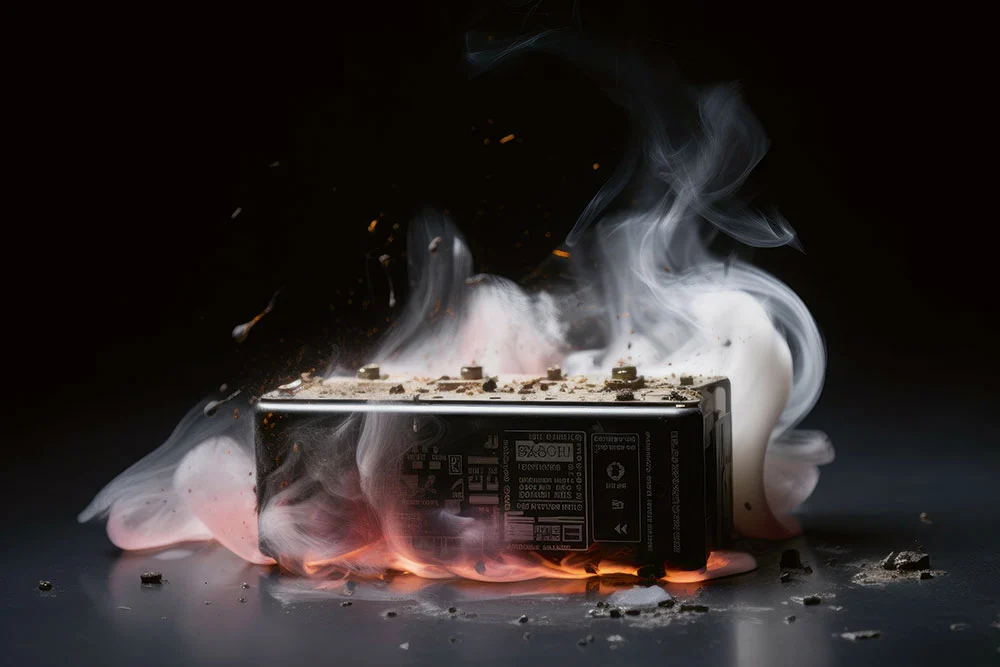Thermal runaway in lithium-ion batteries
In chemistry, a thermal runaway occurs when a reaction generates heat, thereby increasing the reaction rate and causing the reaction to get out of control. In lithium-ion batteries, the effect of heat can trigger unwanted chemical reactions that are themselves exothermic, i.e. generate heat, and thus accelerate themselves. This is also referred to as thermal runaway.
The metal oxides often used in lithium-ion batteries decompose at higher temperatures and release oxygen in the process. This can react with other materials in the cell – e.g. organic electrolytes, graphite or plastics – and thus generate even more heat. The resulting hot gases initially cause the housing of the battery to inflate. Finally, they escape under high pressure in the form of a jet flame, which can also burn for longer. The battery may even explode.
In addition to the flames and the risk of explosion, the rapidly developing smoke also poses a risk. It can contain hydrochloric acid gas and hydrofluoric acid gas, among other things.
Risk factors for thermal runaway
The heat required for thermal runaway can either be supplied from outside or be generated within the cell itself – for example due to overloading or a short circuit. Important risk factors for thermal runaway are therefore:
- Hot environment and sunlight: Lithium-ion batteries should therefore not be stored near flames or hot motors, for example, or in the sun. This applies in particular during operation and charging, as this generates additional heat. Heated batteries must first be cooled down to the core before they are charged or used again.
- Overcharging and deep discharging: If a battery is charged above its end-of-charge voltage or deep discharged, this can lead to damage. For example, dendrites can form. These lithium bridges between the electrodes can cause internal short circuits.
- External short circuits: If a short circuit occurs due to accidental contacts or defective devices, this leads to high current flows and an excessively rapid discharge of the battery. Both can lead to overheating.
- Mechanical stress and foreign bodies: Mechanical stress or ingress of foreign bodies can lead to electrical contact between the cathode and anode. A great deal of heat can be generated at the point of such a short circuit.
Collection centres for old batteries are therefore particularly at risk. Lithium-ion batteries that are mechanically damaged or deeply discharged are regularly handed in there. In addition, short circuits can occur in the collection containers. Craftsmen, who often handle electrical tools roughly and sometimes work in very hot conditions, can also be easily affected.
Behaviour in the event of a thermal runaway
A lithium-ion battery that undergoes a thermal runaway and therefore explodes can cause serious injuries. The jet flames can not only cause fires, but also lead directly to severe burns. The smoke produced by thermal runaway is also toxic. Even relatively small lithium-ion batteries, such as those in smartphones and e-cigarettes, can therefore cause serious damage to health if they catch fire.
What's more, burning lithium-ion batteries are almost impossible to extinguish. This is because the fire is protected inside the housing and produces its own oxygen. Therefore, such fires cannot be smothered. At best, the only thing that can be done is to prevent the fire from spreading to other cells.
The following measures should therefore be taken in the event of a thermal runaway:
- Protect people: Batteries that become very hot, inflate or start to smoke represent an acute danger. They must therefore be kept away from people. For example, they should be taken out of your trouser pocket or put out of your hand. Rooms in which a battery is on fire should be evacuated immediately.
- Disconnect from the circuit: If overheating occurs during charging or operation, it may help to unplug the device or switch it off. This can sometimes interrupt an incipient thermal runaway.
- Prevent the spread of fire: If it is still safe to do so, batteries having a thermal runaway should be kept as far away as possible from other flammable materials – or vice versa. It is best to remove the battery from the building or at least place it on a non-flammable surface – for example in a pot or on tiles.
- Cooling: In the early phase of thermal runaway, the chemical reaction can still be interrupted if as much heat as possible is dissipated. Overheating batteries should therefore be cooled. This even applies to batteries that are already burning, as this can often prevent thermal runaway in further cells. The most effective method is prolonged immersion in water.
Fireproof boxes for rechargeable batteries
Thermal runaway is very rare with lithium-ion batteries. However, it can never be completely ruled out, even with careful handling. The charging process is particularly critical. If you want to be on the safe side, you can charge, transport and store your batteries in a fireproof lithium battery container such as our RETRON BOX. Such containers protect against splinters in the event of explosions, prevent the spread of fire and reduce the formation of smoke thanks to fire pillows.



